How To Fix Tire Rubbing On A Truck
Is your tire rubbing against the inside of your wheel well? Or is it rubbing against the fender flares of your truck? Is there any way to fix this?
Tire rubbing is one of the things car, truck, van, and bike owners alike hate. The friction caused by the tire rubbing against the metal surface is one of the main reasons why tires prematurely wear down. Not addressing this immediately can have disastrous effects not just to your pockets but also to your life and limbs.
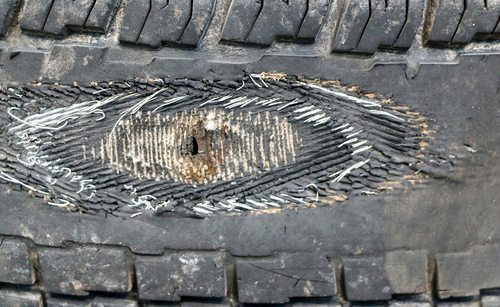
We’re here to discuss tire rubbing and what you can do to address it if it happens to you and your truck. And at the first sign of tire rubbing, consider getting a good replacement like these Cooper Cobra Radial G/T All Season Tires.
Related Topic: Truck Vs. Pickup: What’s The Difference?
What Causes This?
There are a lot of factors involved in tire rubbing. Incorrect wheel size, small wheel wells, incompatible fender flares, and rusted parts are just some of the ones on top of the list. A faulty or damaged suspension system can also be the suspect.
Overloading your vehicle is also another reason.This usually happens when truck owners unknowingly add incompatible parts to their trucks in a bid to either increase its functionality or aesthetic appeal. Too often, not doing your research can lead to a great monetary loss or worse damage to your personal property.
Even the most experienced truck owners can fall victim to this.
This only became quite evident when slammed trucks became all the rage a few decades ago. Before that, tire rubbing was only an issue sedans and other conventional cars experienced.
Related Topic: Are Diesel Trucks More Expensive To Own And Maintain?
Incorrect Wheel Size
One of the most common reasons why tire rubbing exists is due to installing incorrect wheels onto a truck. For most truck owners, bigger, taller, and wider tires are a must-have for that macho appeal.
Sadly, looks don’t always result to functionality. Bigger, wider, or taller tires often rub against the inside or the sides of the wheel well. This may not happen all the time, but slight vertical travel as the tire pounds against the road is bound to result into tire rubbing.

Related Topic: Can You Put Smaller Tires On An SUV?
Another reason that you should look into is your tire’s inflation level. A flat tire is going to take on a wider, deformed shape when you add weight to it and run it on the road. To do preventive maintenance on your tires, get the AstroAI Digital Tire Inflator with Pressure Gauge to check your PSI level.
You should also invest in a Rocboc Wireless Smart Tire Safety Monitor in your cab to keep real time monitoring on your tires as you drive it from point A to point B.
For more on truck safety, check this article out: Why Your Truck Is Leaking A Red Fluid (And Is It Safe To Drive?)
Small Wheel Wells
Hard to believe but there are trucks out there that have small wheel wells. You’ll usually find these in the smaller variants. Micro trucks to utes are notorious for having small wheel wells. This isn’t entirely a design flaw. It’s more of an engineering design meant to accommodate creating smaller versions of oversized trucks.
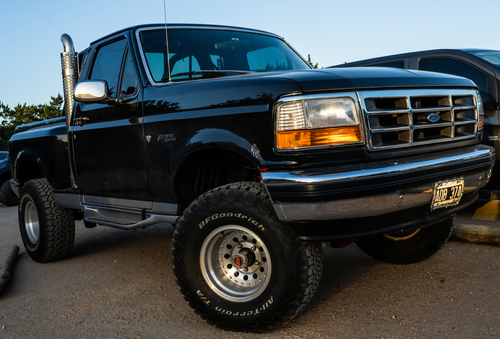
The smaller size also meant smaller engines and as a necessity, smaller tires for fuel efficiency and handling. Because these vehicles were intended to house smaller tires, the selection for aftermarket replacements were also limited.
Incompatible Fender Flares
Fender flares on trucks are commonplace nowadays. The old aluminum trim that used to adorn older trucks have been replaced with ABS plastic, oversized fender flares that increase the visual appeal of these vehicles.
The issue of tire rubbing arises when the inside portions of the fender flare cut into the space provided for the tires.

These may look good, but at the cost of damaging your tires, these are probably not a good investment.
Rusted Parts
The majority of your truck is built out of metal. As such, rust will eventually find its way into your vehicle. You can protect exposed parts with a good layer of metal protectant to stop rust from occurring.
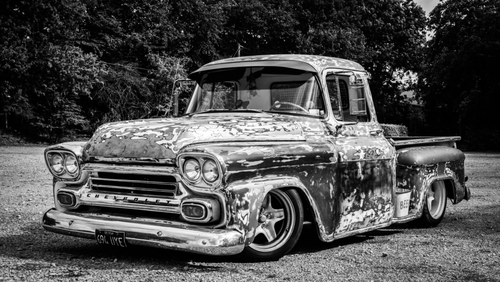
As to why this happens to pickup trucks, here’s an article about that: Why Do Pickup Trucks Rust So Much?
Faulty Or Damaged Suspension System
Driving around with a faulty or damaged suspension can be a bone jarring experience. Any road imperfection is sure to make your shocks bottom out causing your truck to buck like a wild bronco. So, save your teeth and always perform a regular preventive maintenance on your truck’s suspension to avoid this.
There are aftermarket suspension systems that you can use to further improve your ride. Riding on stock suspension systems will only last for as long as your warranty covers it. Once you notice a change in the ride quality, start hunting for higher quality, suspension systems.
To get you started in the right direction, here are a few examples:
- BellTech 444 Lowering Kit
- BellTech 686ND Lowering Kit with Nitro Drop
- AIR LIFT 59103 Slam Air Adjustable Air Spring Kit
- AIR LIFT 88204 LoadLifter 5000 Ultimate Spring Kit
- BellTech 6400 Shackle Kit
- BellTech 964 Lowering Kit
- QSA Rear Axle Flip Kit
- Maxtrac Suspension 410520 Rear Lowering Shackle
- BellTech 614 Lowering Kit
- BellTech 964 ND Lowering Kit with nitro Drop
- KSP Rear Lowering Shackle Kit
Overloading Your Vehicle
Normally, a truck can carry loads greater than most vehicles out on the road today. Trucks are rated to sit two to four people within the cab and a minimum of a hundred pounds back in the bed without any issue.
You should check your trucks GVWR and loading capacity to ensure this doesn’t happen to you. Staying well within the limits of your truck’s carrying capacity will prevent tire rubbing due to overloading. If you’re in doubt, check the owner’s manual at all times and weigh your cargo if possible, before loading it into the bed.
Related Topic: 15 Pros And Cons Of Heavier Cars
The Appeal Of Slammed Trucks
Back in the 90s everyone wanted their vehicle sitting low on the ground. The lower, the better. This applied to cars, vans, bikes, and yes, trucks.
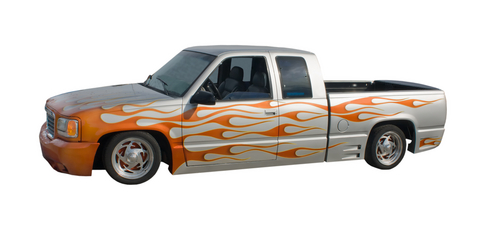
Now, this is easy for all other types of vehicles but extremely hard to pull off with a truck. You see, trucks are extremely long. Even the shortest ute is longer than most cars. Pulling off a lowered look without making it look awkward takes a lot of science and calculations.
Another factor that makes trucks extremely hard to slam into the ground is their chassis construction. The ladder frame has built in inclines that raise the bed higher than the cab. Most slammed trucks end up with a custom rail that costs an absurd amount of money.
That didn’t stop people from still wanting to do it.
Related Topic: Are Pickup Trucks Practical? Real World Pros And Cons
That’s when lowering kits and airbags came into play. For those who just wanted to make their truck sit lower on the ground, this was an easy fix that they could either do themselves or let a professional garage do.
When done right, slammed trucks look extremely nice. Most truck owners opted for a uniform look, modified engines, wild graphics, and of course, going as low as possible.
It was a popular trend that has continued to live on to this day. And a lot of owners experienced tire rubbing in the worst ways with projects gone bad.
How To Address This Situation
There are several solutions to addressing tire rubbing. Here’s a list of what you can do:
Pick The Right Tires
This is the first and most obvious thing to stop tire rubbing from taking place in the first place. For best results, always consult your owner’s manual and the manufacturer’s recommendations.
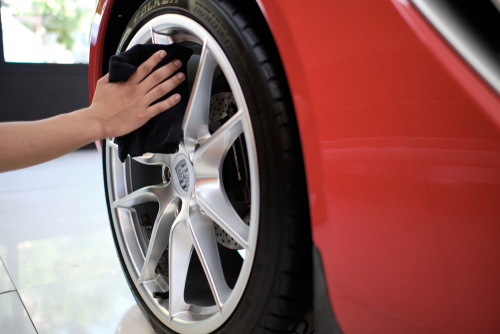
Another reason why you really should put a lot of consideration into picking the right tires is its effect on your mileage and the toll it takes on your engine. Bigger tires are heavier and will require your engine to work harder to turn it properly. That extra effort means more fuel is expended during operation.
Handling is also affected by your tire size. Wider tires are harder to steer. It also takes its toll on your power steering system. It goes without saying that narrower tires maybe a good option for your truck in terms of steering ease although visually, it won’t be as appealing.
For more about handling, check this article out: Are Big Cars Hard To Drive? Here Are Some Truths
Installing taller tires can also cause tire rubbing if you don’t have a suspension system built to take the vertical travel needed by the shocks when going over road imperfections. This will also have an effect on your RPM and odometer. The numbers may show incorrect values if not calibrated properly.
You could go for an off-set combination where you have narrower tires up front and wider ones out back. This is a popular choice for another truck segment. Take note, this presents a whole new set of issues which we can discuss in another article.
For more on caring about your tires, check this article out: Caring For SUV Tires: What To Do, Why, And When
Shave Your Wheel Wells
This is one of the modifications you should take a lot of time to consider simply because doing so is something that can’t be undone. For best results, consult a truck modification shop and allow them to make the proper measurements before cutting into the metal.

Make sure the wheel wells are properly crimped and no sharp edges are present. This way, you can avoid any untoward incidents from happening, especially if you accidentally bottom out and the tire comes into contact with the wheel well edge and inside surfaces.
Install The Right Fender Flares
Bigger isn’t always better. That’s just a toxic macho idea. Sure, it will make your jeep or truck more masculine but at the cost of tire rubbing. Maybe the effect on your tires and truck isn’t just worth those oversized fender flares.
The best thing you can do is get fender flares recommended by the manufacturer. There are also aftermarket parts that are compatible with your truck. Check these Bushwacker Flat Style Fender Flares out. They’re perfect for large wheel wells mostly found on trucks and jeeps. As to why Trucks and Jeeps are considered different from each other, here’s an article discussing that in detail: What’s The Difference Between Trucks And Jeeps?
If you’re handy with a cutting tool, you can custom fit these Kyostar Universal Fender Flares for that new school appeal.
Replace Rusted Parts
Check the underside of your wheel wells and determine if they need fixing or replacing. Rusted out parts can be remedied by cutting out the corroded areas and replacing them with new panels. After doing this, make sure to apply a generous layer of rust-oleum and other metal surface protectants.
It is also recommended to wash these areas off with clean water from a power washer every time you drive your truck in sandy, snowy, muddy or salty areas. Top it off with a good layer of Armor All Car Tire Foam 9767.
Related Topic: Can You Drive An SUV On The Beach?
Modify Your Suspension System
If you really want to go for a lowered or slammed look, you should look into modifying your suspension system. Conventional truck chassis aren’t designed to go as low as show winner slammed trucks. So too are old trucks (a popular choice for truck modifiers).
To get the full effect, a new chassis has to be installed. This requires a body-off modification to achieve that low, ground-scraping look.

With a full-custom chassis, you can assign the height of the shock towers accordingly. You can also reassign the position of the rear tires by lengthening or shortening the rear axles as fit. Allocations for air bags can then be assigned all over the new chassis to raise or lower the body when in use or parked.
You may also need to make modifications to your car’s engine bay to make room for over-sized tires by cutting into it. The truck bed should also receive the same type of treatment. Make sure you fortify the entire thing to reduce the risk of misalignment in the future.
While you’re at it, consider getting rid of noise by checking these articles out: How To Stop Truck Doors From Rattling and 10 Reasons Why Your SUV Squeaks
Don’t Overload Your Truck
This is a no-brainer. Your truck, however invincible the manufacturer’s ads may make it seem, isn’t immune to wear and tear. Constantly overloading your truck’s suspension system is going to have irrevocable effects on its longevity.
If you really have to carry a load around, consider getting a tow hitch and pulling a trailer behind you.

Check these articles out for our recommendations on hitches: Do All SUVs Have Hitches? and Do All Pickup Trucks Have Hitches?
Conclusion
Tire rubbing isn’t just damaging to your wheels, it could also prove quite dangerous to life and limb for people in and outside the vehicle.
It is in your best interest to address it immediately. The solutions we’ve discussed are just some of the few suggestions that you can do to your truck. If in doubt, got to any qualified truck modification shop and they can provide a solution for you. With the right amount, you could even have it done right there and then.
If you’re doing this DIY style, make sure you get a good measuring tool like the Aramox Tire Measurement Tool to ensure you follow the age old saying: “measure twice, cut once”.
Related Questions
Can I Drop My Ride Without Fear Of Rubbing?
Yes. There are lots of aftermarket parts nowadays that will allow you to do it without fear of tire rubbing. Truck customizers used to do one-off pieces in the past. These were unique and very expensive. Now, you can just visit any car shop and get the parts you need off the shelves for a good price.
Can I Still Go Off-Roading With A Slammed Truck?
No. Slammed trucks are built for show and going slow on flat roads with little to no impediments. Anything bigger than an inch deep pothole will damage to your underside. Not to mention that real off-road machines have specialized suspension systems. Going off-road is simply out of the question.
Can You Drive A Slammed Truck For Uber?
Yes. Although there’s a grey area here. If you’re pickup truck is too old, you can throw that idea out of the window. If the modifications you’ve made pose any danger to your passenger, that’s also a no-no. Learn more about driving for Uber with this article: Can Pickup Trucks Drive For Uber?










